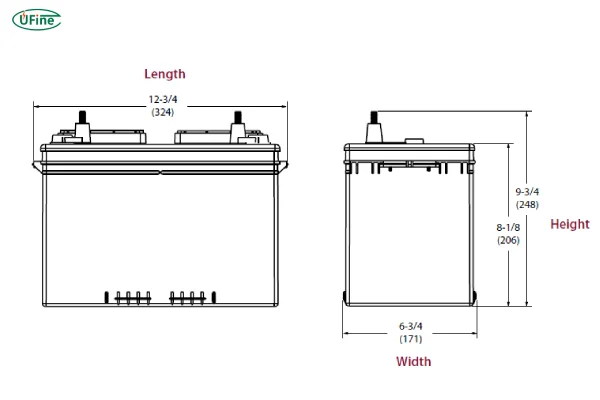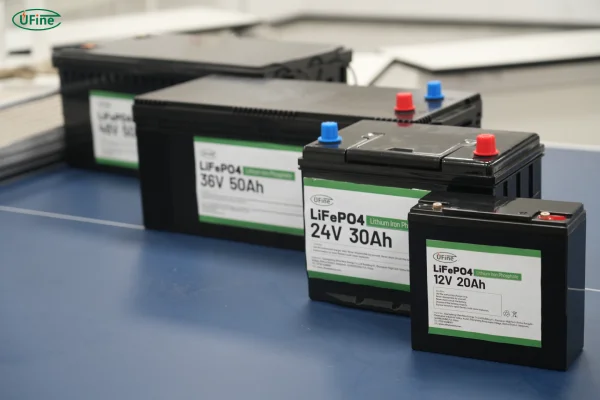In this guide, we’ll take a deep dive into the deep cycle battery size, why they matter, and how to choose the right size for your applications. From understanding what deep cycle battery size means to providing a chart of common sizes, we’ll help you make an informed decision.
Part 1. Learn deep cycle battery size
When we talk about “size” in the context of deep cycle batteries, we are referring to the physical length, width, and height of the battery. These dimensions are critical because they dictate how well the battery will fit into the space available for installation, whether in a boat, RV, solar setup, or electric vehicle.
Unlike standard car batteries that focus more on burst power, deep cycle batteries are designed to provide continuous power over a longer period. This means that their size and capacity go hand in hand, with larger batteries typically offering higher energy storage (measured in Ah, or amp-hours) and longer runtimes.
However, the physical size also affects the battery’s weight and portability, as well as how easy or difficult it will be to manage during installation. Choosing a battery with dimensions that fit your system is vital to ensure the system operates efficiently and safely.
The Battery Council International (BCI), an industry organization, defined these battery sizes through a series of standardized categories. These categories ensure that batteries fit in specific slots and meet performance needs for common applications like RVs, boats, and backup power systems.
Part 2. Common deep cycle battery sizes
Let’s take a look at some of the most common deep cycle battery sizes. This chart provides the length, width, and height of each battery, giving you a sense of the space required for installation.
| Battery Size | Dimensions (L x W x H) |
|---|---|
| Group 24 | 10.3″ x 6.6″ x 8.7″ |
| Group 27 | 12.0″ x 6.8″ x 8.9″ |
| Group 31 | 13.0″ x 6.8″ x 9.4″ |
| Group 4D | 20.5″ x 10.5″ x 9.8″ |
| Group 8D | 20.7″ x 10.9″ x 9.3″ |
| Group 29 | 12.0″ x 6.5″ x 8.7″ |
| GC2 | 10.0″ x 7.1″ x 11.0″ |
| L16 | 11.5″ x 7.3″ x 16.3″ |
| T-105 | 10.3″ x 7.1″ x 11.0″ |
| 12V AGM | 12.1″ x 6.9″ x 8.4″ |
The sizes listed above are for the most common deep cycle batteries, but keep in mind that actual dimensions can vary slightly depending on the manufacturer. You should always check the specific dimensions of a battery before purchasing to ensure it fits in the available space.
Part 3. How to choose the right deep cycle battery size?
Choosing the right physical size for a deep cycle battery isn’t just about picking the largest or smallest option available. Instead, the ideal size depends on several factors:
Step 1: Measure the Available Space
The first step in choosing the right battery size is to measure the space where the battery will be installed. This is especially important in tight spaces such as small boats, RVs, or solar storage systems, where there may not be much room for error.
- Length: Make sure the battery’s length will fit comfortably without crowding other components.
- Width: Ensure the battery is wide enough to provide stability and won’t shift during use or transport.
- Height: Some systems, particularly marine setups, may have height restrictions. Make sure the battery fits without causing interference with other equipment.
Step 2: Match Your Power Requirements
Once you’ve determined the available space, match the battery size to your power needs. A larger battery (in terms of physical size) will typically have more capacity, but that’s not always the case. If you have specific power requirements (such as a need for a higher amp-hour capacity), you may need to prioritize that over size alone.
For example, if you’re using the battery to power heavy-duty equipment or a large RV, you’ll likely need a Group 31 or 4D size battery, which provides a lot of power in a larger physical package. On the other hand, if you only need to power a small solar setup or lights in an RV, a Group 24 battery will suffice and save you space.
Step 3: Consider Battery Weight
In many cases, the larger the battery, the heavier it is. If your installation site has weight restrictions (for example, if the battery is being used in a boat or mobile setup), make sure to account for the weight of the battery in addition to its physical dimensions. Batteries with larger capacities, such as Group 8D or L16 sizes, tend to be significantly heavier and may require additional support.
How Much Does a Deep Cycle Battery Weigh?
Part 4. Applications for different deep cycle battery sizes
The right battery size is not only determined by its physical fit but also by the application. Here’s a breakdown of how different deep cycle battery sizes are commonly used:
-
Group 24 and Group 27 (12V, 70–105Ah): These smaller batteries are ideal for light to moderate power needs. They are often used in small to medium RVs, boats, and off-grid systems. If you are only powering basic equipment like lights and small appliances, these sizes are perfect due to their compact size and relatively lower weight.
-
Group 31 (12V, 100–125Ah): As one of the most popular sizes for larger RVs and boats, these batteries can handle more demanding loads, such as larger refrigerators, multiple lighting circuits, and small air conditioning units. They also offer a good balance between capacity and physical size.
-
Group 4D and Group 8D (12V, 150–255Ah): These larger batteries are typically used in heavy-duty applications where high power output is needed. They are commonly found in large RVs, commercial vehicles, and backup power systems. If you have a large off-grid solar setup or industrial equipment, these larger sizes are usually required.
-
GC2 and L16 (6V): These batteries are used primarily in golf carts, floor scrubbers, and solar applications. They are often arranged in series to create higher voltage configurations. Their larger size allows them to provide consistent power over long periods, especially in applications that require deep discharges.
Part 5. What size do marine batteries come in?
Marine batteries are designed to withstand the unique demands of a boat’s electrical system. Like RVs, boats require deep cycle batteries that can handle extended discharges and recharges. The physical size of the battery plays an essential role in determining how much power it can supply.
Marine batteries typically come in 12V sizes, including Group 24, Group 27, and Group 31. However, for larger vessels with higher power requirements, batteries such as Group 4D, Group 8D, or even 6V deep cycle batteries (like GC2 and T-105) are often used. The choice of battery size depends on the electrical needs of the boat, how many devices you need to power, and the physical space available in the battery compartment.
Part 6. Conclusion
Understanding deep cycle battery size is crucial to selecting the right battery for your needs. While the capacity and voltage of the battery are important, the physical dimensions—including the length, width, and height—are just as essential. These factors determine not only how much power the battery can provide but also whether it will fit into the available space and be manageable during installation.
By carefully considering the space requirements and power needs for your specific application, you can choose the perfect deep cycle battery size. Whether you’re powering an RV, a boat, a solar system, or any other application, the right size battery will ensure efficiency, reliability, and long-lasting performance.
Related Tags:
More Articles

How to Choose the Best Floor Scrubber Battery for Commercial Cleaning?
Selecting the ideal floor scrubber battery ensures a long runtime, rapid charging, and minimal maintenance for efficient commercial cleaning operations.
Battery for Blower vs Battery for Leaf Vacuum: Which One Should You Choose?
Battery for blower vs leaf vacuum—learn the key differences in power, fit, and runtime to choose the right battery for your outdoor tool needs.
How to Choose the Right Battery for Blower?
Choosing the right blower battery? Consider voltage, capacity, chemistry & usage. This guide helps match the best battery for peak performance.
How to Choose the Best Insulated Battery Box for Lithium Batteries?
Choosing the Best Insulated Battery Box for Lithium Batteries? Discover key factors such as size, material, and safety for optimal protection and performance.
7 Critical Elements on a Lithium Battery Shipping Label
What must be on a lithium battery shipping label? Learn 7 key elements to ensure safety, legal compliance, and correct handling across all transport modes.





